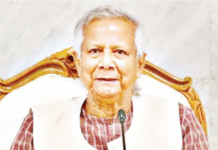23 Indian hydropower projects to be completed by this year, may reduce Teesta flow
This photo taken last month shows the once mighty Teesta river has almost dried up. The river was like this for miles. The photo was taken at Teesta village in Lalmonirhat.
The operation of twenty-three Indian hydropower projects, set to be completed within this year, will hold back the Teesta river water upstream and reduce its flow, according to a leading water expert of India.
“Once the 23 hydropower projects start operating by late 2013, the flow of waters would further reduce during daytime and affect irrigation downstream,” the Hindustan Times quoted river expert Kalyan Rudra as saying.
Kalyan, assigned by West Bengal Chief Minister Mamata Banerjee to determine the current water flow of the Teesta in India, said, “The river biodiversity, water table and its ecological flow would go for a toss.”
Although the Teesta is the fourth major river flowing into Bangladesh from India, its water flow has fallen to around 1,000-2,000 cubic metres per second (cusec) from a past typical flow of 10,000 cusecs.
The Teesta, which historically has been a mighty river, has already receded to knee-deep level, thanks to various irrigation and water diversion projects in India.
India plans to irrigate more than nine lakh hectares of its land diverting the Teesta water. On the other side, Bangladesh already irrigates more than six lakh hectares of its land from the river.
Kalyan Rudra says irrigating more than 15 lakh hectares of land in total in the two countries, is “unrealistic” even with the river’s current flow, which would further decline once the projects are launched.
Hydrologists in Bangladesh also have expressed concerns over the projects, saying the launch of these power plants would further reduce water flow and affect the river’s ecosystem.
Hydrologist M Inamul Haq, chairman of the Institute for Water and Environment, Bangladesh, said, “In the lean period, they [India] divert some water [from Teesta] to the Mechi river through the Mahananda and hold back the rest. We only get some regenerated flow after they hold it back.”
“The flow of the Teesta will reduce further when those hydropower projects are launched,” he observed.
Around 14 percent of the total cropped land of Bangladesh depends on the Teesta, says a study, “The Political Economy of Water Governance in South Asia”. The Asia Foundation conducted the study and released its report last month after surveying in both India and Bangladesh.
The river also provides livelihood opportunities directly or indirectly to approximately 9.15 million people, around 7.3 percent of the total population of Bangladesh, in five northern districts.
Eminent hydrologist Dr Ainun Nishat told The Daily Star if India wanted to build a dam on any trans-boundary river, it would have to inform Bangladesh as it was also “our river”.
Dr Nishat, also vice-chancellor of Brac University, added the joint communiqué Prime Minister Sheikh Hasina and her Indian counterpart Manmohan Singh signed in 2010 spoke of a basin-wide management of the trans-boundary rivers, which could be one of the approaches.
Currently, Bangladesh and India have a water sharing treaty only on the Ganges out of 54 trans-boundary rivers.
Signing of a Teesta treaty during Manmohan’s visit Dhaka in September 2011 was postponed as West Bengal Chief Minister Mamata Banerjee threw a spanner in the works.
“We are yet to get any exact date or timeframe from India about the signing of the [Teesta] treaty,” said Sheikh Altaf Ali, secretary of the water resources ministry.
One his way back from a conference held in Durban recently, the Indian PM before a group of journalists reiterated his hope of signing the Teesta treaty.
Mir Sazzad Hossain, member of the Joint Rivers Commission (JRC), said, “If we had plenty of water in the Teesta, we would not have to sign any treaty.”
Meanwhile, the JRC Bangladesh has opposed construction of two hydro-based power projects along the Indo-Bangladesh border in Meghalaya until the two countries sign a water sharing agreement, insiders say.
Meghalaya is in the process of constructing the dams in two rivers — the Mawphu dam across the Umiew and Myntdu dam across the Myntdu — in East Khasi Hills and West Jaintia Hills districts respectively.
Bangladesh, however, has taken an initiative to form an alliance with its three South Asian neighbours India, Bhutan and Nepal for cooperation and production and sharing of hydroelectricity in the trans-boundary rivers.
The country has made a list of nine proposed hydropower plants which it could Benefit from. The JRC sources say at least two dams in the Teesta and those two of Meghalaya are included in the nine.
A meeting of representatives from Bangladesh, India and Bhutan has already taken place in Dhaka.
Source: The Daily Star










